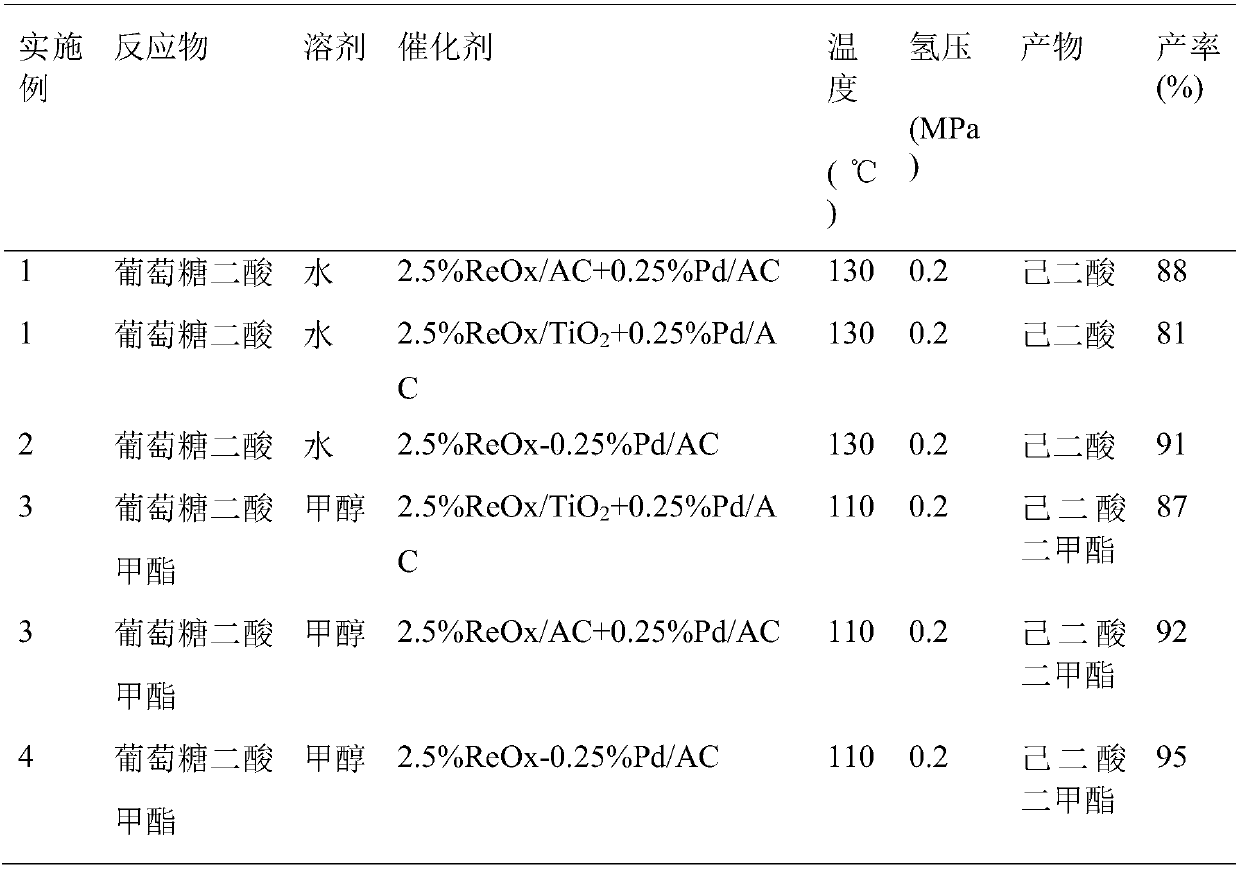Method for preparing adipic acid from glucaric acid
A technology of glucaric acid and adipic acid is applied in the preparation of carboxylate, carboxylate, and carboxylate/lactone, etc., and can solve the problems of unfriendly environment, high equipment corrosion and high production cost, Achieve the effect of reducing production cost and high catalytic performance
- Summary
- Abstract
- Description
- Claims
- Application Information
AI Technical Summary
Problems solved by technology
Method used
Image
Examples
preparation example Construction
[0034] 1. Preparation of supported Pd catalyst
[0035] The preparation of 0.25% Pd / AC catalyst is taken as an example for non-limiting illustration.
[0036] 68 μL of 10wt% Pd(NH 3 ) 4 (NO 3 ) 2 Mix the aqueous solution with 10.0mL deionized water, stir evenly, then add 1.00g of AC carrier (the Chinese name is activated carbon) into the mixture, stir and impregnate at room temperature for 10 hours, evaporate the water to dryness, and then dry it in an oven at 110°C After 12 hours, a catalyst precursor was obtained. The loading amount of Pd is 0.25% (mass percentage). The precursor prepared in the above steps was placed in a quartz tube, first calcined in nitrogen at 500 ° C for 2 h, and then in 20% H 2 +N 2 Reduction at a temperature of 300° C. for 1 h to obtain a supported 0.25% Pd / AC catalyst.
[0037] 2. Preparation of supported ReOx catalyst
[0038] With 5%ReOx / TiO 2 The preparation of the catalyst is used as an example for non-limiting illustration.
[0039] ...
Embodiment 1
[0047] Embodiment 1, prepare adipic acid in aqueous solution
[0048] With 5%ReOx / TiO 2 and 0.25% Pd / AC mechanically mixed catalyst as an example for non-limiting illustration.
[0049] In a 50mL autoclave, add 0.2g of 5%ReOx / TiO 2 , 0.2g of 0.25% Pd / AC catalyst and 15mL of 2% glucaric acid aqueous solution in mass percentage, after the reactor was sealed, filled with 1MPa hydrogen to replace the residual air in the reactor, after repeating three times, pour into the reactor 1MPa hydrogen gas was filled, the reaction kettle was placed on a heating furnace to be heated to a reaction temperature of 130°C, and the reaction was stirred for 10 hours at a rotation speed of 700rpm. After the reaction finished, take out the reaction kettle from the heating furnace, cool to room temperature, reduce the pressure in the kettle to normal pressure, open the lid, take out the liquid-solid mixture and separate it by suction filtration, and analyze the liquid obtained by liquid chromatograp...
Embodiment 2
[0050] Embodiment 2, prepare adipic acid in aqueous solution
[0051] The 5%ReOx-0.25%Pd / AC co-supported catalyst is taken as an example for non-limiting illustration.
[0052] In a 50mL autoclave, add 0.2g of the above-mentioned 5%ReOx-0.25%Pd / AC catalyst and 15mL of a 2% glucaric acid aqueous solution by mass percentage, and after the autoclave is sealed, fill it into a 1MPa hydrogen replacement autoclave After three repetitions, the reactor was filled with 1MPa hydrogen, and the reactor was placed on a heating furnace to be heated to a reaction temperature of 130° C., and the reaction was stirred at a speed of 700 rpm for 10 hours. After the reaction finished, take out the reaction kettle from the heating furnace, cool to room temperature, reduce the pressure in the kettle to normal pressure, open the lid, take out the liquid-solid mixture and separate it by suction filtration, and analyze the liquid obtained by liquid chromatography. And calculate the conversion and produ...
PUM
 Login to View More
Login to View More Abstract
Description
Claims
Application Information
 Login to View More
Login to View More - R&D
- Intellectual Property
- Life Sciences
- Materials
- Tech Scout
- Unparalleled Data Quality
- Higher Quality Content
- 60% Fewer Hallucinations
Browse by: Latest US Patents, China's latest patents, Technical Efficacy Thesaurus, Application Domain, Technology Topic, Popular Technical Reports.
© 2025 PatSnap. All rights reserved.Legal|Privacy policy|Modern Slavery Act Transparency Statement|Sitemap|About US| Contact US: help@patsnap.com

